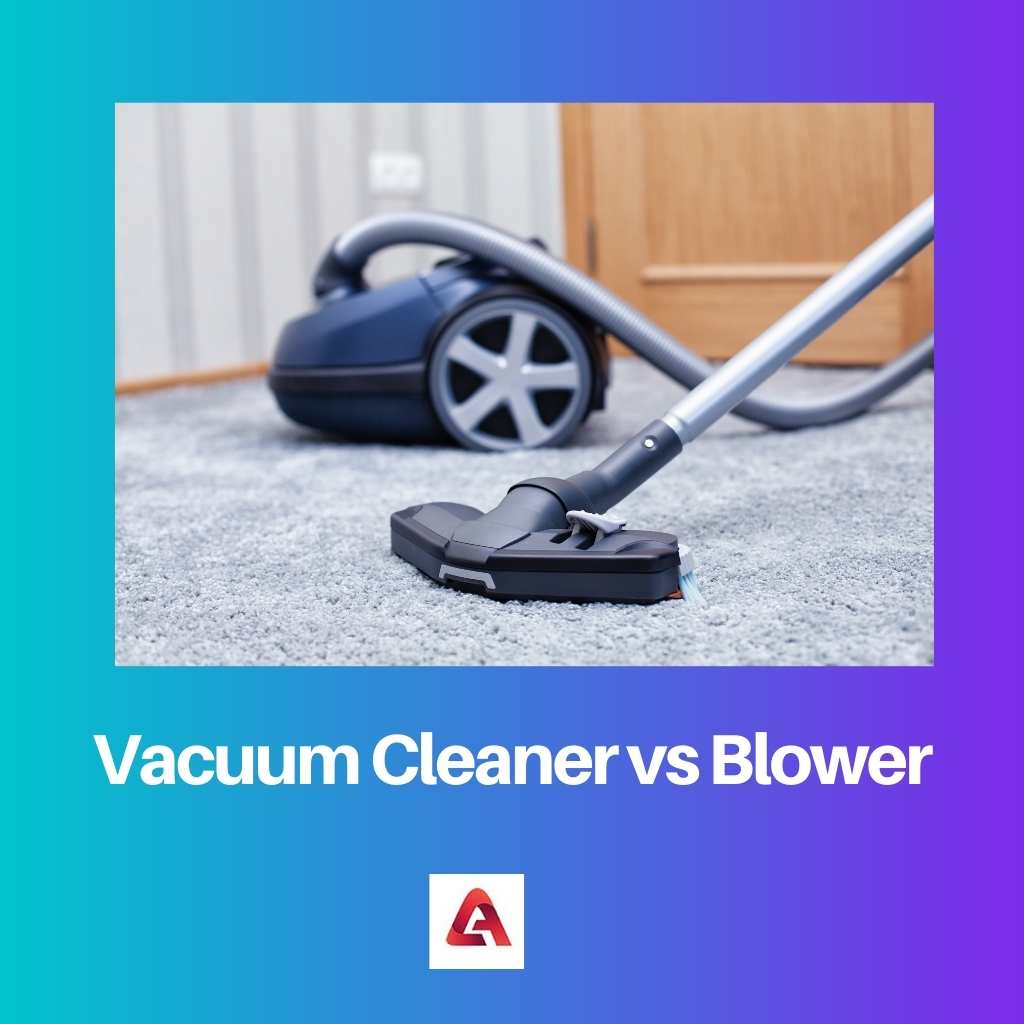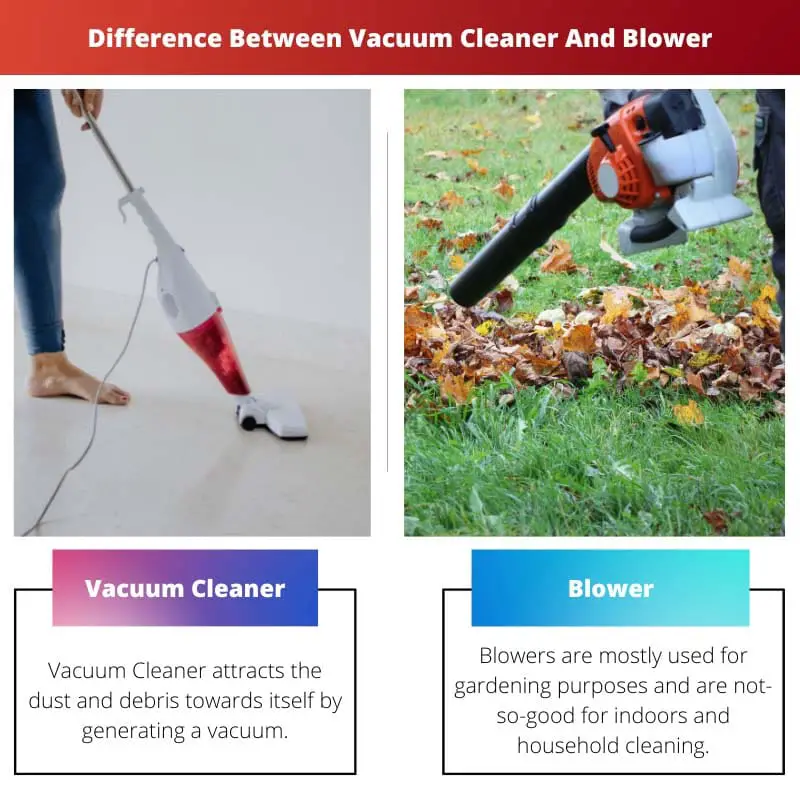Cleanliness and hygiene are the essentials for living a healthy life. Keeping your surroundings clean protects you from getting diseases as you are not in contact with pathogens.
Traditionally, water was used for cleaning, and it was sometimes mixed with detergent. But later, methods that used air for cleaning were developed.
Key Takeaways
- Vacuum Cleaner is used to suck in dust and debris, while Blower is used to blow away dust and debris.
- Vacuum Cleaner is more effective in cleaning carpets and upholstery, while Blower is better for outdoor cleaning.
- Vacuum Cleaner consumes more power than Blower and is more expensive.
Vacuum Cleaner vs Blower
A vacuum cleaner comes with various attachments, such as crevice tools, upholstery brushes, etc., that help to clean different surfaces and areas. A blower comes with various nozzles that are designed for specific cleaning purposes like blowing items out of tight spaces like gutters, etc.

Vacuum Cleaner attracts the dust and debris towards itself by generating a vacuum. This vacuum is created because the Vacuum Cleaner sucks air and with it, the dirt particles get inside the cleaner too.
Inside the cleaner, these dirt particles are filtered and stored for the user to easily remove them. Blowers clean by blowing air over the dust. The stream of air displaces the dirt and debris and leaves a clean place.
Blowers are mostly used for gardening purposes and are not-so-good for indoors and household cleaning as they blow the dirt and don’t collect it for proper disposal afterward.
Comparison Table
| Parameters of Comparison | Vacuum Cleaner | Blower |
|---|---|---|
| Working Principle | Works by sucking air | Works by blowing air |
| Powered by | Electric motor | Electric and gasoline motors |
| Storage for dust | Vacuum Cleaners can store the dust after cleaning | Blowers can’t store the dust |
| Noise production | Vacuum Cleaners don’t make harsh noise | Gasoline Blowers can make harsh noise |
| Size of the machine | A vacuum Cleaner is relatively a large machine | Blowers are smaller than Vacuum Cleaners |
| Invented in (year) | 1901 | 1977 |
| Invented by | Hubert Cecil Booth | Echo company |
What is Vacuum Cleaner?
A vacuum Cleaner is a mechanical device that uses an electrical motor to run a fan that pulls air inside, hence creating a temporary vacuum.
Naturally, with the air that comes in, the dust and dirt in the atmosphere also get inside the vacuum cleaner and get stored in a dust bag.
After a user has used the machine, he/she can open the vacuum cleaner and take out the dirtbag and dispose of the garbage.
The technology a Vacuum Cleaner uses dates back to the 1860s, but it wasn’t until 1901 when Hubert Cecil Booth invented a powered Vacuum Cleaner.
Also, Booth is attributed with coining the term “vacuum cleaner”. Someone said to Booth that it was impossible to create a machine that could suck the dirt and then filter it. Booth took this challenge and developed the exact machine.
With new technologies being introduced, like every other thing, Vacuum Cleaners have developed too. Other than the common types like Handheld, Upright, Canister, and Stick Vacuum Cleaner, there are now Robot Vacuum Cleaners that can operate without human interaction.
Robot Vacuum Cleaners work just like the normal cleaner, but they have a special algorithm installed that helps them to automate the task.

What is Blower?
Blower, just like the name says it, is a machine designed to throw or blow air. Blowers or leaf blowers use an electric or gas-powered motor to run a fan that can create and emit an air stream.
The gas-powered Blowers are considered a cause for noise pollution as they are very loud. Also, since Blowers are designed to blow the dust away, there is no way to store it for proper disposal.
This is the reason why Blowers are not used for household cleaning but are frequently used for gardening.
The initial design of a Blower was created by Kyoritsu Noki Company in 1947. The design was for a backpack fogger. But, in 1972, Kyoritsu was established as Kioritz Corporation of America in the US, and in the year 1977, they invented the Blower.
In 1978, Kioritz Corp changed to Echo. Some of the different types of Blowers available in the market are Positive Displacement, Centrifugal, Regenerative and High-Speed Blowers.
These are the common mechanisms found in a Blower that allows it to generate and blow air. All of these mechanisms are very complex and yet simple if someone understands them, and each of them has its advantages and disadvantages.
Main Differences Between Vacuum Cleaner And Blower
- Vacuum Cleaner works by sucking air as compared to Blower which works by throwing air.
- Vacuum Cleaners use an electric motor to run the fan that creates suction whereas Blowers run on an electric or gas motor.
- Vacuum Cleaners have the space to store the filtered dust that comes with air whereas Blowers aren’t made for storing the dirt, they are made to blow it.
- Vacuum Cleaners work with little noise and don’t produce harsh sounds. On the other hand, Blowers, especially the gas-powered ones, are known for making loud noises.
- Vacuum Cleaners are larger than Blowers.
- Vacuum Cleaner was invented in 1901 whereas Blower was invented in 1977.
- Vacuum Cleaner was invented by Hubert Cecil Booth whereas Blower was invented by a company called Echo.

- https://books.google.com/books?hl=en&lr=&id=NaVGk3HBUdkC&oi=fnd&pg=PP1&dq=vacuum+cleaner+history&ots=Qvm_6l1J2T&sig=c-6MQsxL6SxqtYf1a4mj3fiy2w8
- https://www.tandfonline.com/doi/full/10.1080/10455752.2011.593896
